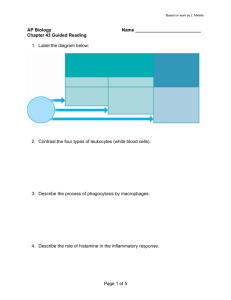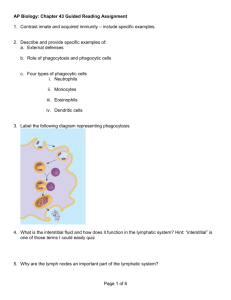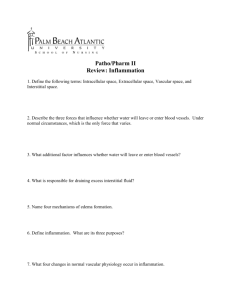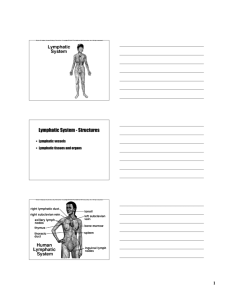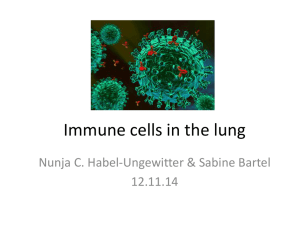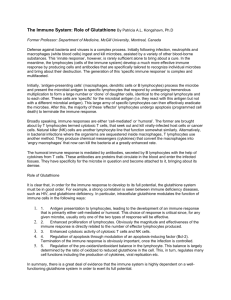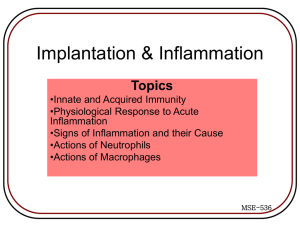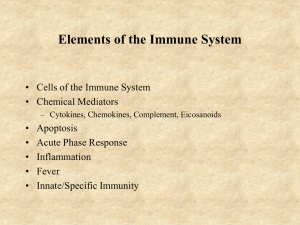Fire Ant Stings and Other Mishaps: Immnology
advertisement
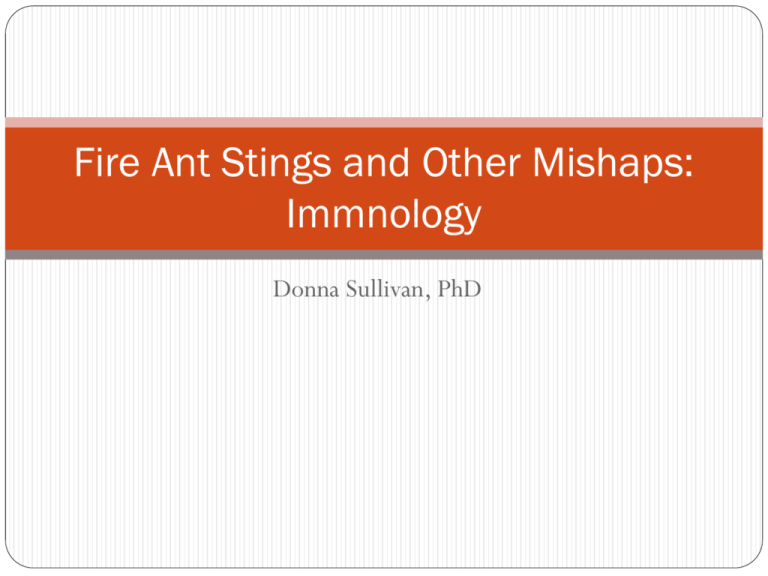
Fire Ant Stings and Other Mishaps: Immnology Donna Sullivan, PhD Host Defensive Systems 1st line of defense intact skin mucous membranes and their secretions 2nd line of defense phagocytic white blood cells inflammation -complement fever -interferon 3rd line of defense B and T lymphocytes antibodies 2 nonspecific specific Physical or anatomical barriers Outermost layer of skin is composed of epithelial cells 3 compacted, cemented together and impregnated with keratin Flushing effect of sweat glands Damaged cells are rapidly replaced Mucous coat impedes attachment and entry of bacteria Blinking and tear production Stomach acid Nasal hair traps larger particles Chemical Defenses Sebaceous secretions Lysozyme, an enzyme that hydrolyzes 4 the cell wall of bacteria, in tears High lactic acid and electrolyte concentration in sweat Skin’s acidic pH Hydrochloric acid in stomach Digestive juices and bile of intestines Semen contains antimicrobial chemical Vagina has acidic pH DIFFERENTIATION OF CELLS 5 Leucocytes Granulated: granules, lobed nuclei Neutrophils Eosinophils Basophils Agranulated: un-lobed, round nuclei Monocytes Macrophages, dendritic cells Lymphocytes T cells, B cells 6 GRANULOCYTES Neutrophils (PMNs) Strongly phagocytic, important in controlling bacterial infections Usually first cells to arrive at site Eosinophils Weakly phagocytic, main role in allergic reactions, destruction of parasites Basophils Non phagocytic Cell surface receptors for IgE Mediated allergic and antiparasitic responses due to release of histamine 7 DIFFERENCES BETWEEN NEUTROPHILS AND MACROPHAGES NEUTROPHILS MACROPHAGES Rapid increase in production Only slight increase in blood 8 (and in blood) during acute phase of infection Only found in inflamed tissues Single mature form Rapidly form pus Short-lived; die after phagocytosis during inflammation Found in healthy tissues Multiple mature forms Slowly form granulomas (with T cell help) Long-lived-survive after phagocytosis MONOCYTES/MACROPHAGES Released from bone marrow Circulate in blood and enter tissues where they mature into macrophage Activated macrophage Initiated by phagocytosis of particulate antigens 9 CELLS OF THE MONOCYTEMACROPHAGE SYSTEM BLOOD - MONOCYTES LYMPH NODES RESIDENT & RECIRCULATING MACROPHAGES BRAIN - MICROGLIAL LUNGS - ALVEOLAR SPLEEN - MACROPHAGES KIDNEY - MESANGIAL LIVER - KUPFFER CONNECTIVE TISSUE HISTOCYTES BONE MARROW - PRECURSORS 10 JOINTS - SYNOVIAL A MACROPHAGES: FUNCTION Stand guard Initiate early innate immune response Educate the specific immune system Present antigen associated with Class II MHC to CD4 TH cells Call in the troops Secrete cytokines that promote immune responses Join the battle Phagocytose and inactivate microbes Secrete antibacterial substances, inflammatory mediators, and complement components 11 Phagocytosis 12 NATURAL KILLER CELLS Primary targets of NK cell killing are virus infected and tumor cells May depend on reduced expression of Class I MHC molecules, alterations in surface carbohydrates Mechanism of killing Direct cytotoxicity Antibody dependent cellular cytotoxicity (ADCC) 13 Stages Of Inflammation Blood vessels dilate in response to chemical mediators and 14 cytokines Edema swells tissues, helping prevent spread of infection WBC’s, microbes, debris and fluid collect to form pus Pyrogens may induce fever Macrophages and neutrophils engage phagocytosis Developmental Stages of Monocytes and Macrophages 15 INFLAMMATION Tissue damage due to trauma, caustic agents, microbes Mediated primarily by immune system cells, cytokines Acute inflammation Chronic inflammation 16 Rubor, Calor, Tumor, Dolor Rubor: Redness caused by increase circulation and vasodilation in injured tissues Calor: Warmth, heat given off by increased flow of blood Tumor: Swelling, caused by increased fluid escaping into the tissues Dolor: Pain, causes by stimulation of nerve endings 17 TRAUMA AND INFLAMMATION 18 TRAUMA AND INFLAMMATION 19 TRAUMA AND INFLAMMATION 20 TRAUMA AND INFLAMMATION 21 TRAUMA AND INFLAMMATION 22 Activities Of Phagocytes Stand guard To survey tissue compartments and discover microbes, particulate matter and dead or injured cells Join the Battle To infest and eliminate these materials Educate Specific Immune System To extract immunogenic information from foreign matter 23 Chemical Mediators 24 Complement Consists of 26 blood proteins that work in concert to destroy bacteria and viruses Complement proteins are activated by cleavage Classical pathway Alternative pathway 25 Complement 26 Specific immunities B and T lymphocytes Specificity and memory 27 28 Lymphocyte Development and Differentiation 29 Antigen Presentation Challenge of B and T Cells B Cell Antibody Production T Cell Responses Preliminary concepts Cell receptors or markers confer specificity and identity Major functions of receptors are To perceive and attach to nonself or foreign molecules To promote the recognition of self molecules To receive and transmit chemical messages among other cells of the system To aid in cellular development. 31 How Are Receptors Formed? As a cell matures, certain genes that encode cell receptors are transcribed and translated into protein products with a distinctive shape, specificity and function. Receptor is modified and packaged by the endoplasmic reticulum and Golgi complex. It is ultimately inserted into the cell membrane, accessible to antigens, other cells, and chemical mediators. 32 Receptor Formation in a Developing Cell 33 Major Histocompatibility Complex (MHC) Receptors found on all cells except RBCs Also known as human leukocyte antigen (HLA) Plays a role in recognition of self by the immune system and in rejection of foreign tissue Genes for MHC are located on chromosome 6, clustered in a multigene complex of classes I, II, III 34 MHC Receptors 35 Functions of MHC Class I – markers that display unique characteristics of self molecules and regulation of immune reactions Required for T lymphocytes Class II – receptors that recognize and react with foreign antigens. Located primarily on macrophages and B cells Involved in presenting antigen to T cells Class III – secreted complement components, C2 and C4 36 Clonal Selection Theory Lymphocytes use 500 genes to produce a tremendous variety of specific receptors Undifferentiated lymphocytes undergo genetic mutations and recombinations while they proliferate in the embryo forming a billion different clones with the ability to react with a tremendous variety of antigens. 37 Ability to React to Every Antigen Is PreProgrammed Lymphocyte specificity is preprogrammed, existing in the genetic makeup before an antigen has ever entered the system. Each genetically different type of lymphocyte expresses a single specificity. First introduction of each type of antigen into the immune system selects a genetically distinct lymphocyte and causes it to expand into a clone of cells that can react to that antigen. 38 Structure of Antibodies 40 Immunoglobulins Immunoglobulin genes lie on 3 different chromosomes Undifferentiated lymphocyte has 150 different genes for the variable region of light chains and 250 for the variable region and diversity region of the heavy chain During development, recombination causes only the selected V and D genes to be active in the mature cell. 41 Gene Segments of Immunoglobulins Heavy chains Variable (V) Diversity (D) Joining (J) Constant (C) Light chains Variable (V) Joining (J) Constant (C) 42 HYPERSENSITIVITY REACTIONS Type I (immediate) hypersensitivity: IgE-mediated atopic (allergic) and anaphylactic reactions Type II hypersensitivity: Ab-dependent cytotoxicity Type III hypersensitivity: Immune complex induced tissue damaging inflammation Type IV (delayed) hypersensitivity:Cell-mediated cytotoxicity 44 45 TYPE II REACTIONS: Blood Typing and Transfusion Reactions 46 47 TYPE IV (DTH) REACTION: TB Skin Test 48 IMMUNE REACTIONS DUE TO MATERNAL ANTIBODIES 50 Insect Stings Normal reaction: local pain, erythema, swelling Onset 10-15 minutes Subsides in 1-2 hours Therapy: cool compresses, analgesics Insect Stings Large, local reactions Peak at 48 hours Duration of 1 week Occasional fatigue, nausea Not IgE mediated Therapy: antihistamines, prednisone Insect Stings Anaphylaxis: IgE mediated Generalized urticaria, flushing, angioedema, cardiorespiratory symptoms Onset 15-20 minutes up to 72 hours Adults have highest mortality Prevention: avoidance, EpiPen, immunotherapy if skin test positive Fire Ant Stings Fire Ant Stings Ferocious; potent venom; multiple stings Intense pain followed by pruritis Immediate flare (2-5cm) and wheal (≤1cm) 8-10 hours later a sterile pustule develops Systemic reactions (16%) rarely life threatening Fire Ant Stings Chance of being stung 50% Reactions Wheal & Flare 100% Pustule 96% Large local reaction 3.6-56% Secondary infection 54% Systemic 16% Cutaneous Life-threatening 0.6-2% Deaths 32 http://afrsweb.usda.gov/fireant/venom.htm?pf=1 Allergic Reaction: Possible Causes Insect bites/stings (bees, wasps, etc.) Food (nuts, crustaceans, peanuts, etc.) Plants Medications Others Findings Skin Warm, tingling feeling Face, mouth, chest, feet, and hands Itching Hives Respiratory System Tightness in throat/chest Cough Swelling of the airway Rapid breathing Noisy breathing Labored breathing Inability to speak or cough Retractions Hoarseness Use of accessory muscles Stridor Wheezing (audible without stethoscope) RESPIRATORY FAILURE! RESPIRATORY ARREST! Cardiovascular System Increased heart rate Decreased blood pressure Decreased perfusion (shock) due to vasodilation Generalized Findings Itchy, watery eyes Headache Sense of impending doom Runny nose Other Signs and Symptoms Decreasing mental status Signs of shock (hypoperfusion) Respiratory distress Emergency Medical Care Patient has prescribed epinephrine? Facilitate administration of preloaded epinephrine. Reassess every 2 minutes. No auto-injector CALL 911!!! Transport to ER
